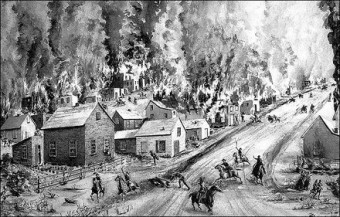The Sacking of Osceola
 In 1861 in southwestern Missouri, near its border with Kansas, the city of Osceola was sacked by rabid anti-slavery jayhawkers (from Kansas). When the looting and burning were over, ten people were dead and the city was ruined.
In 1861 in southwestern Missouri, near its border with Kansas, the city of Osceola was sacked by rabid anti-slavery jayhawkers (from Kansas). When the looting and burning were over, ten people were dead and the city was ruined.
The Jayhawkers
Brigadier General James Henry Lane led the 3rd, 4th and 5th Kansas Volunteers- soldiers who were staunchly free soil riding under the name of Jayhawkers.
The Kansas volunteers had been charged with the difficult task of breaking the Confederate hold on southwestern Missouri. Outnumbered, in open warfare, the Jayhawkers lost several conflicts, including their defeat in the Battle of Dry Wood Creek.
The anti-slavery troops found that less direct tactics were more effective, and General Lane was an advocate of “hard war” methods – where non-military targets, and in particular economic assets, were attacked.
The Sacking
Historians disagree over Lane’s motivations for targeting Osceola, Missouri. Some argue that Lane wanted to destroy his political enemy, the Missouri Senator Waldo P. Johnson, a Confederate sympathizer at the time. Others ascribe more noble motives, and hold that Lane wanted to stop Missouri’s secession, while also freeing slaves. Regardless, on the eve of the attack, Lane is reported to have instructed his men: “Everything disloyal from a Durham cow to a Shanghai chicken must be cleaned out.”
On the morning of September 23, 1861, Lane and his contingent of 2000 Jayhawkers attacked the town. Faced by only 200 Bushwhackers under the command of Missouri Guard Captain John Weidemeyer, the Kansas volunteers had little trouble overpowering them, and the Missourians, who lost one man in the battle, were forced to retreat.
The Jayhawkers looted goods, supplies and money, and in fact, it was reported that they:
Succeeded in capturing a heavy train of supplies destined for the armies of Generals Rains and Price, together with $100,000 in money.
In a frenzy, the troops reportedly got “so drunk that when it came time to leave, they were unable to march and had to ride in wagons and carriages.”
The Kansans also burned “almost everything in sight, including all but three of the town’s 800 buildings.”
General Lane’s total take was reported in The Newark Advocate and elsewhere:
Three hundred and fifty horses and mules, four hundred head of Price’s cattle, large droves of sheep and swine . . . 200 slaves . . . 3,000 sacks of flour, 500 pounds of sugar and molasses [and] 50 pounds of coffee.
Other reports note that Lane took for his private use, a piano and “a quantity of silk dresses.”
Before leaving, Lane held a mass summary hearing, and then executed nine Osceola residents, bringing the death toll up to ten.
The Aftermath
Many believe the sacking of Osceola was the primary justification given by the Bushwhackers for their massacre in Lawrence, Kansas two years later. On the morning of August 21, 1863, 400 Missouri soldiers raided the town where General Lane resided, burning the city and killing between 160 and 190 boys and men.
General Lane survived the Lawrence Massacre by running and hiding in a cornfield.
If you liked this article, you might also enjoy our new popular podcast, The BrainFood Show (iTunes, Spotify, Google Play Music, Feed), as well as:
- 8 Amazing History Stories
- 20 Interesting Dr. Martin Luther King Jr. Facts
- The Largely Forgotten Paris Massacre of 1961
- The Last Veteran of the Civil War
- Famed Bankrobber John Dillinger Once was a Professional Baseball Player
Bonus Facts:
- Approximately 620,000 troops died during the U.S. Civil War (1861-1865) – about 360,000 from the Union and nearly 260,000 from the Confederacy.
- It is estimated that about 50,000 civilians died as a result of the war, and that the “overall mortality rate for the South exceeded that of any country in World War I.”
- In direct expenditures, the Civil War cost the Union about $3.2 billion at the time, which, adjusted for inflation, would be $59 billion today (well, 2011). For the Confederacy, direct expenditures are estimated at nearly $2.9 billion in 1860 dollars or nearly $54 billion today.
- In the aftermath of the Civil War, over 100 national cemeteries were created to bury soldiers who died from the war, as well as veterans who passed away afterward. Virginia, alone, has 18.
| Share the Knowledge! |
|





One comment